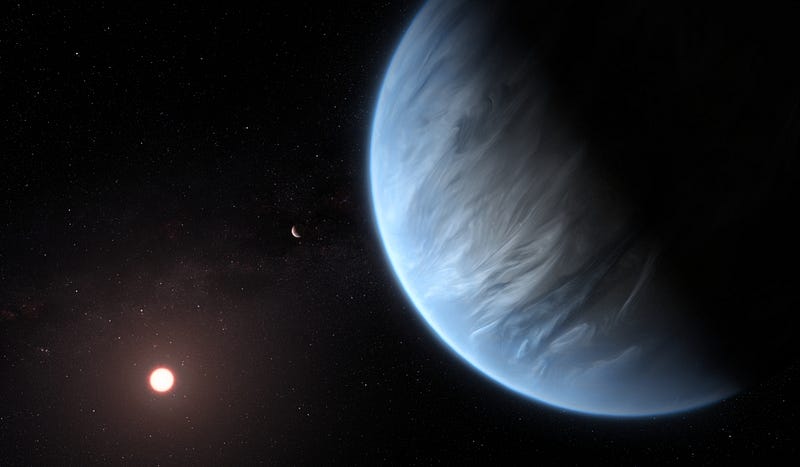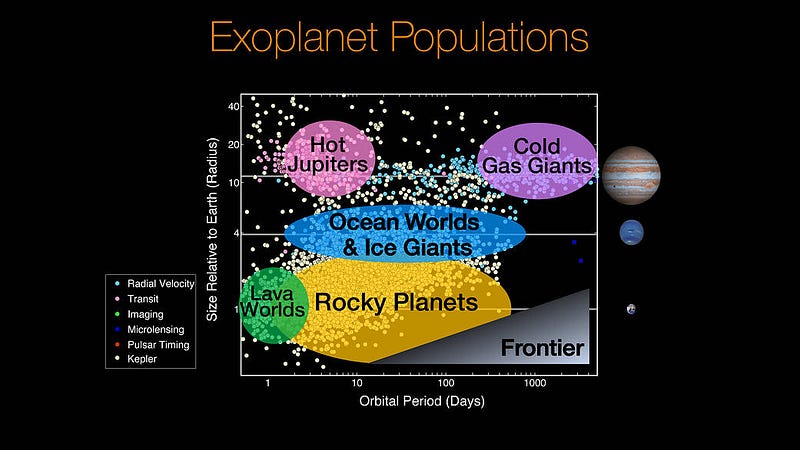Exciting Discovery: Water Found on Habitable Exoplanet K2–18b
Written on
Chapter 1: Introduction to K2–18b
Since 1992, astronomers have identified over 4,000 exoplanets orbiting distant stars. However, the confirmation of water on a potentially habitable planet has eluded researchers until now. The exoplanet K2–18b resides within the habitable zone of its star, an area where conditions are ideal for liquid water to exist on a planet's surface—a region often referred to as the Goldilocks Zone.
An international team of astronomers has made a groundbreaking discovery by detecting water vapor in the atmosphere of K2–18b. This finding represents the first confirmation of water on an exoplanet located in a habitable zone.

This artistic representation illustrates K2–18b, its host star, and an accompanying planet in the system. K2–18b is currently the only known super-Earth exoplanet that possesses both water and the right temperature conditions to support life. Researchers from UCL utilized archived data from the NASA/ESA Hubble Space Telescope, collected in 2016 and 2017, employing open-source algorithms to analyze the starlight passing through K2–18b’s atmosphere. Their analysis unveiled the molecular signature of water vapor, along with the presence of hydrogen and helium in the planet’s atmosphere. According to Dr. Angelos Tsiaras from the UCL Centre for Space Exochemistry Data (CSED), this discovery is thrilling: "Finding water in a potentially habitable world other than Earth is incredibly exciting. K2–18b is not ‘Earth 2.0’ as it is significantly heavier and has a different atmospheric composition. However, it brings us closer to answering the fundamental question: Is the Earth unique?"
Section 1.1: Characteristics of K2–18b
K2–18b, discovered in 2015, is a super-Earth with a mass eight times greater and a size 2.4 times that of our planet. It is one of numerous super-Earths—exoplanets larger than Earth but smaller than Neptune—that inhabit various alien planetary systems.

Astronomers discovered K2–18b using the transit method, observing the planet as it passed in front of its star from Earth. This approach enabled researchers to measure the planet's size and calculate its mass based on its gravitational influence on its parent star. K2–18b completes an orbit around its star every 33 days, situated at a distance approximately 14% that of Earth's orbit. Given its proximity to its star, the surface of K2–18b likely experiences a higher radiation level than we do on Earth.
With a density of around 3.3 grams per cubic centimeter (compared to Earth's 5.5), K2–18b could be a silicate world with a dense atmosphere or a planet rich in oceans. The red dwarf star, K2–18, is located 110 light-years from Earth and has a mass about 40% that of our sun, with a surface temperature around 3,200 degrees Celsius (5,850 Fahrenheit). An unconfirmed planet, K2–18c, was identified in 2017, which orbits its star every nine days.
Subsection 1.1.1: Potential for Life
As scientists explore whether K2–18b could support life, several criteria must be met: the planet should reside in the habitable zone of its star and possess a solid surface or liquid oceans. The ongoing search may soon reveal more Earth-sized or slightly larger planets with moderate temperatures and atmospheric pressures conducive to water accumulation.
"Super-Earths—planets lighter than ten Earth masses—around later-type stars may provide our first opportunity to study spectroscopically the characteristics of such planets, as they are best suited for transit observations," researchers note in the journal Nature Astronomy.

Data from the Hubble Space Telescope (HST) captured in 2016 and 2017 was analyzed, focusing on starlight filtering through K2–18b's atmosphere. The researchers found that the atmosphere is primarily composed of hydrogen and helium, with the presence of water vapor. While this environment would be inhospitable to humans, it could potentially support life forms adapted to such conditions.
Chapter 2: The Future of Exoplanet Exploration
The quest for exoplanets is set to advance significantly, thanks to new telescopes and instruments both on Earth and in space. The TESS spacecraft is anticipated to discover hundreds of super-Earths orbiting distant stars. The James Webb Space Telescope, the most sophisticated space telescope ever launched, is preparing for a journey spanning a million miles, while the European ARIEL mission plans to conduct detailed examinations of 1,000 exoplanets starting in 2028.
The first video titled Earth 2.0: Water found for first time on potentially habitable planet delves into the groundbreaking discovery of water on K2–18b and its implications for the search for life beyond Earth.
The second video, Water found for first time in atmosphere of planet outside Earth's solar system, explores the significance of detecting water vapor in the atmosphere of K2–18b and what it means for our understanding of habitable worlds.
As Dr. Ingo Waldmann from UCL CSED remarks, "With so many new super-Earths expected to be found over the next couple of decades, this is likely the first discovery of many potentially habitable planets." The prevalence of super-Earths in our galaxy and the abundance of red dwarf stars suggest that many exoplanets may share characteristics with K2–18b. The detection of water on this temperate world enhances our understanding of the diversity and composition of planets orbiting other stars, allowing us to learn more about our celestial neighbors.